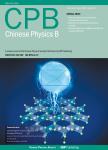Effects of MgSiO3 on the crystal growth and characteristics of type-Ib gem quality diamond in Fe-Ni-C system
Effects of MgSiO3 on the crystal growth and characteristics of type-Ib gem quality diamond in Fe–Ni–C system作者机构:State Key Laboratory of Superhard MaterialsCollege of PhysicsJilin UniversityChangchun 130012China Key Laboratory of Materials Physics of Ministry of EducationSchool of PhysicsZhengzhou UniversityZhengzhou 450001China
出 版 物:《Chinese Physics B》 (中国物理B(英文版))
年 卷 期:2020年第29卷第12期
页 面:511-518页
核心收录:
学科分类:07[理学] 070205[理学-凝聚态物理] 08[工学] 080501[工学-材料物理与化学] 0805[工学-材料科学与工程(可授工学、理学学位)] 0703[理学-化学] 0702[理学-物理学]
基 金:Project supported by the National Natural Science Foundation of China(Grant Nos.51772120,51872112,and 11804305) the China Postdoctoral Science Foundation(Grant No.2017M622360) the Project of Jilin Science and Technology Development Plan(Grant No.20180201079GX)
主 题:diamond MgSiO3 nitrogen content recrystallized graphite
摘 要:We report the effects of MgSiO3 addition on the crystal growth and characteristics of type-Ib diamonds synthesized in Fe–Ni–C system. The experiments were carried out with pressure at 5.5 GPa, temperature at 1385℃–1405℃, and duration of 23.1 h. As MgSiO3 increases from 0.0 wt% to 3.0 wt%, the diamond growth temperature increases from1385℃ to 1405℃, the addition of MgSiO3 and the movement of P–T diagram toward the higher temperature direction result in a series of effects to the Fe–Ni–C system and crystal growth. Firstly, it increases the content of metastable recrystallized graphite and accelerates the competition with the carbon source needed for diamond growth, thus causing the decreased crystal growth rate. Diamond crystals exhibit the combination form of {111}, {100}, {113}, and {110}sectors, the decreased {100} and {113} sectors, dominated {111} sector are all attributed to the higher growth rate in [100]direction caused by the synergy of MgSiO3 and the movement of P–T diagram. The higher growth rate in [100] direction also increases the metal catalyst and graphite inclusions and leads to the increase of residual tensile stress on the crystal surface. Accompanying with the high growth rate, a higher dissolution rate along [100] and [113] directions than [111]direction occurs at the microstructure and forms the significantly developed(111) stepped growth layer. In addition to the movement of P–T diagram, the addition of MgSiO3 poisons the catalyst and increases the nitrogen content of diamond from 120 ppm to 227 ppm.



